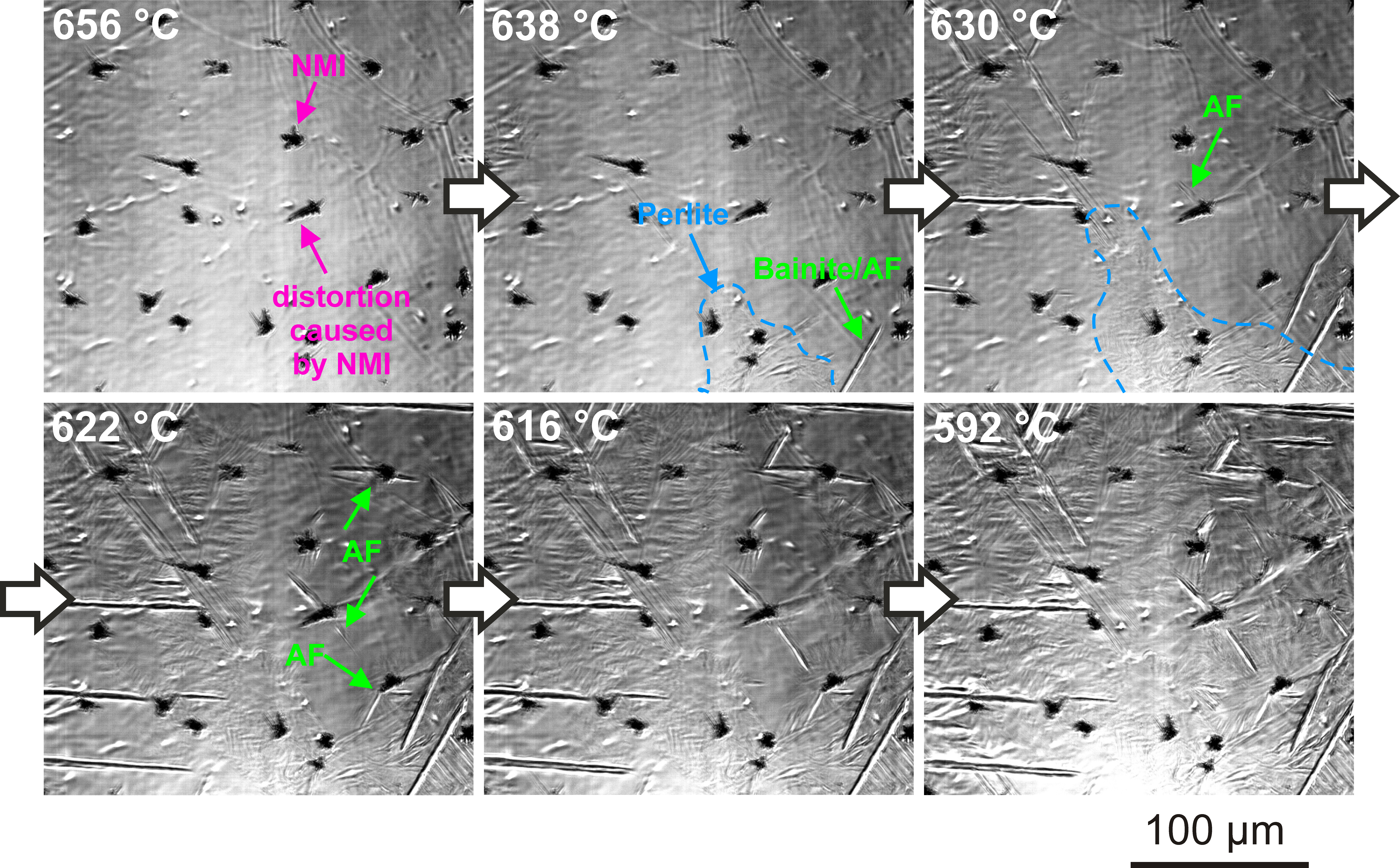Project Title:
Systematic Improvement of Steel Properties by means of Inclusion Metallurgy
Project Cooparations:
Rian Dippenaar (University of Wollongong in Australia)
Project Description:
Due to the wide variety of application fields, the material steel is an essential component not only for a continuous technical progress in transportation or infrastructure but also in our daily life. In the year 2010 more than 1410 million tons of steel were produced worldwide, what underlines its potential and necessity. In terms of a possibly high quality and the avoidance of material failure, several aspects have to be considered in steelmaking. One factor that can essentially influence steel properties is the steel cleanness. The latter describes the number, size, distribution and composition of so-called non-metallic inclusions in the steel matrix.
Although in general non-metallic inclusions are regarded to have a negative effect on steel properties, there are interesting aspects dealing with the positive influence of inclusions on steel microstructure. For example can inclusions act as heterogeneous nuclei for acicular ferrite. Acicular Ferrite is a not equiaxed form of ferrite, which forms a chaotic microstructure of laths and plates nucleating intergranularly at non-metallic inclusions. This chaotic structure leads to an improvement of several steel properties, like toughness, transition temperature or fracture toughness. The aim of this project is the specific creation of inclusions which are potential nuclei for acicular ferrite.
Figures:
References:

Acicular ferrite nucleating on active non-metallic inclusions, forming a fine grained, interlocking microstructure

Especially multiphase inclusions, containing titanium and manganese are found to be active for acicular ferrite

The use of HT-LSCM enables the in situ observation of acicular ferrite’s nucleation and growth, which can provide information about the formation mechanisms
Publications:
PEER-REVIEWED:
- S. Michelic, D. Loder, G. Arth and C. Bernhard. Experimental study on the formation of non-metallic inclusions acting as nuclei for acicular ferrite in HSLA steels through specific deoxidation practice and defined cooling conditions. Material Science Forum, 783-786, 2014, 904-909. DOI:10.4028/www.scientific.net/MSF.783 786.1079.
- D. Loder, S. Michelic, A. Mayerhofer, C. Bernhard and R. Dippenaar. In situ observation of acicular ferrite formation using HT-LSCM: possibilities, challenges and influencing factors. Proceedings of MS&T14, Pittsburgh, USA, 2014, 1-8.
- D. Loder, S. Michelic and C. Bernhard. Characterization of acicular ferrite microstructures using etching methods, optical microscopy and HT-LSCM. Sonderbände der praktischen Metallographie – Fortschritte in der Metallographie 46, Leoben, Austria, 2014, 125-130.
- D. Loder and S. Michelic. Specific use of non-metallic inclusions for the formation of acicular ferrite structures: Thermodynamic modeling and laboratory experiments. Proceedings of the 9th International Conference on Clean Steel 2015, Budapest, Hungary, 1-12.
- D. You, C. Bernhard, G. Wieser and S. Michelic. Microsegregation model with local equilibrium partition coefficients during solidification of steels. Steel research international, 2016, 87, 840-489. DOI: 10.1002/srin.201500216.
- J. Schenk, C. Bernhard and S. Michelic. Contribution of the Chair of Ferrous Metallurgy at the Montanuniversitaet Leoben to Enhance the Sustainability of Steel Production and Application. Berg- und hüttenmännische Monatshefte : BHM, 2015, 160, 10, 489-494. DOI 10.1007/s00501-015-0418-6.
- D. Loder, S. Michelic and C. Bernhard. Systematische Untersuchung der Azikularferritbildung in Stählen. Berg- und hüttenmännische Monatshefte : BHM, 2016, 161, 7, 315-320. DOI:10.1007/s00501-016-0509-z.
- D. Loder and S. Michelic. Systematic investigation of acicular ferrite formation on laboratory scale. Material Science and Technology, 2016. DOI:10.1080/02670836.2016.1165902.
- D. You, S. Michelic, C. Bernhard, D. Loder and G. Wieser. Modeling of inclusion formation during the solidification of steel. ISIJ International 2016, 56, 10, 1-10. DOI: 10.2355/isijinternational.ISIJINT-2016-243.
- D. You, C. Bernhard, S.K. Michelic, G. Wieser and P.Presoly. On the modelling of microsegregation in steels involving thermodynamic databases. IOP Conference Series: Materials Science and Engineering, 119(1), 012027. DOI:10.1088/1757-899X/119/1/012027.
- You, D., Michelic, S.K., Wieser, G. et al. J Mater Sci (2016). doi:10.1007/s10853-016-0470-y.
- Acicular Ferrite Formation and Its Influencing Factors – A Review
Loder, D., Michelic, S. & Bernhard, C. Jan 2017 6, 1, S. 24-43
NON PEER-REVIEWED:
- D. Loder, A. Mayerhofer and S. Michelic. On the formation potential of acicular ferrite microstructure in different steel grades focusing on the influence of carbon content. Proceedings AISTech 2016, Pittsburgh, United States, 2465-2474.
- D. Loder, S. Michelic and C. Bernhard. Systematische Optimierung von Stahleigenschaften durch nichtmetallische Einschlüsse. ASMET Forum für Metallurgie und Werkstofftechnik, Leoben, Austria, 2013.
- D. Loder, S. Michelic and C. Bernhard. Etching Methods for the Computerized Analysis of Acicular Ferrite in Steel Microstructures. Thermec 2013, Las Vegas, USA, 2013.
- D. Hofer, D. Loder, S. Michelic and C. Bernhard. Experimentelle Analyse des Einflusses von Titangehalt und Abkühlbedingung auf den Anteil von azikularem Ferrit im Gefüge. ASMET Forum für Metallurgie und Werkstofftechnik, 2014.
- C. Otto, D. Loder, S. Michelic and C. Bernhard. Ätzmethoden für die computergestützte Analyse von Azikularferrit im Gefüge. ASMET Forum für Metallurgie und Werkstofftechnik, 2014.
- D. Loder, S. Michelic and C. Bernhard. The Use of HT-LSCM for the In situ Observation of Acicular Ferrite, Junior Euromat, 2014.
- A. Mayerhofer, D. Loder and S. Michelic. In Situ Beobachtung der Azikularferritbildung an nichtmetallischen Einschlüssen am HT-LSCM. ASMET Forum für Metallurgie und Werkstofftechnik, 2015.
- A. Mayerhofer, D. Loder and S. Michelic. Bewertung des Potenzials nichtmetallischer Einschlüsse zur azikularferritischen Keimung in verschiedenen Stahlgüten. ASMET Forum für Metallurgie und Werkstofftechnik, 2016.
- A. Mayerhofer, D. Loder and S. Michelic. Non-metallic inclusions Acting as Potential Nuclei for Acicular Ferrite in Different Steel Grades. ISDM, 2016.
- S. Michelic, U. Dieguez-Salgado, D. Loder und C. Bernhard. In situ Beobachtung des Verhaltens nichtmetallischer Einschlüsse mittels Hochtemperatur-Laser-Scanning-Konfokalmikroskopie. Gießerei Praxis 2016, 9, 337-341. (Hybrid OA)
Acknowledgements:
This project is supported by the Federal Ministry for Transport, Innovation and Technology (bmvit) and the Austrian Science Fund (FWF): [TRP 266-N19].




